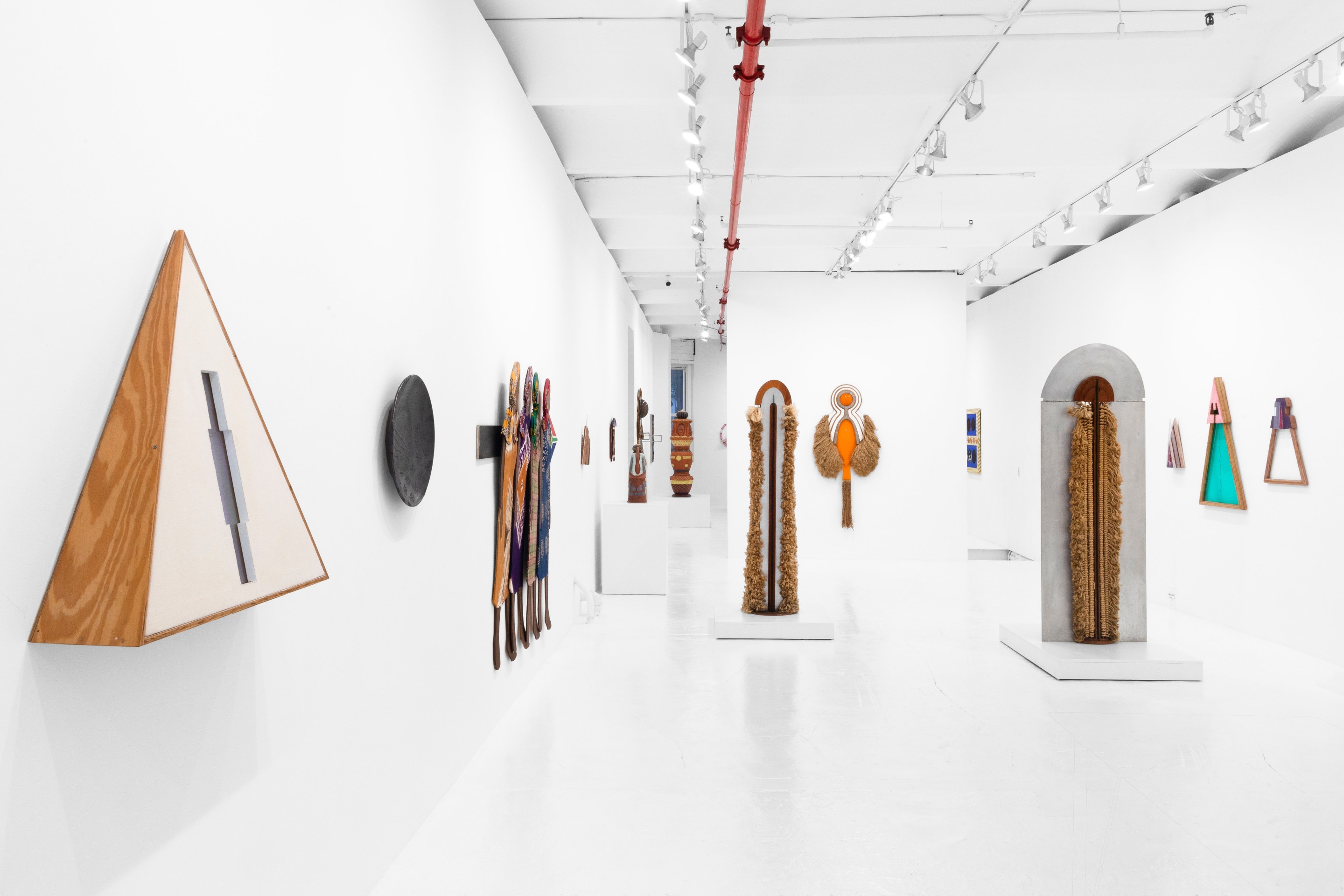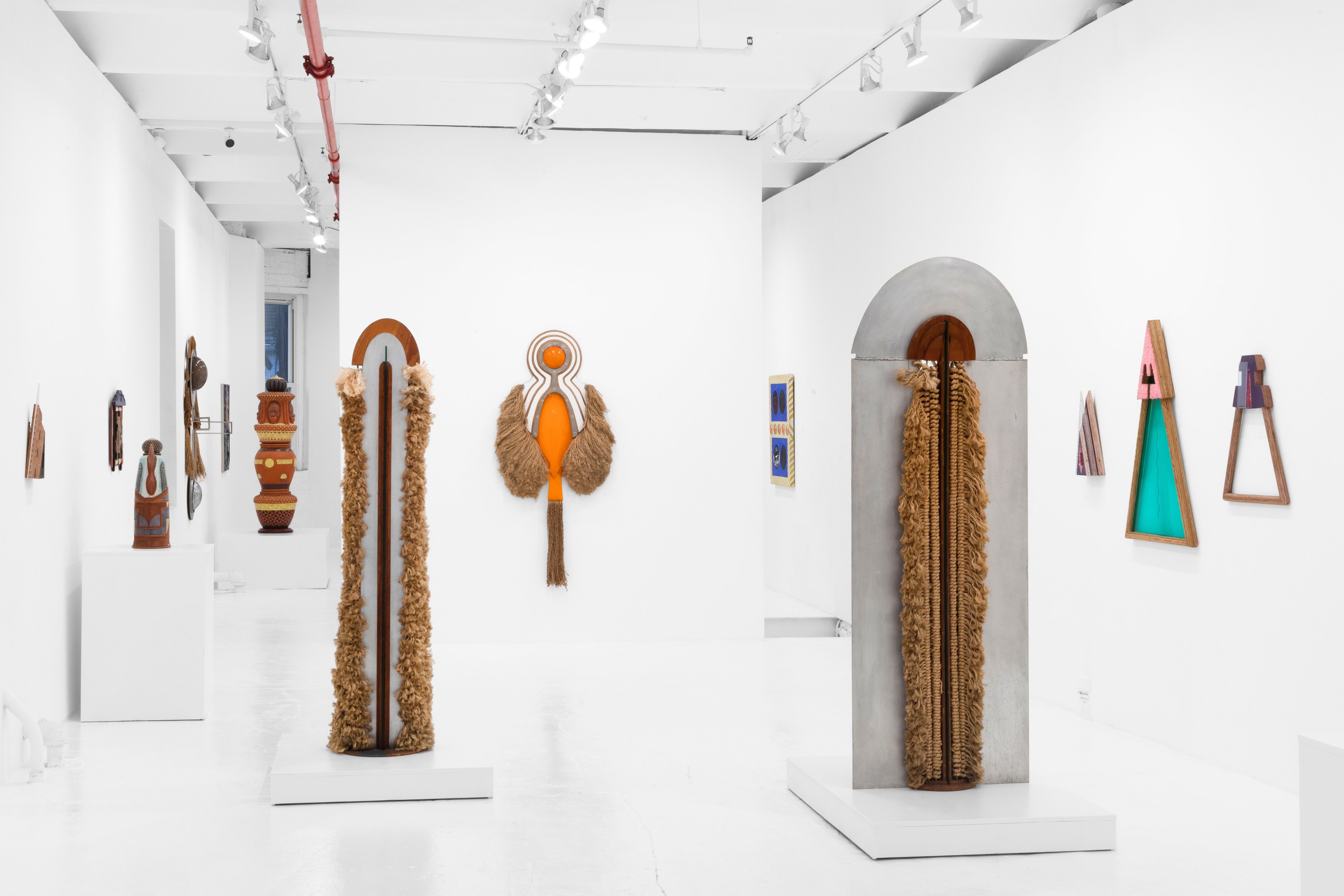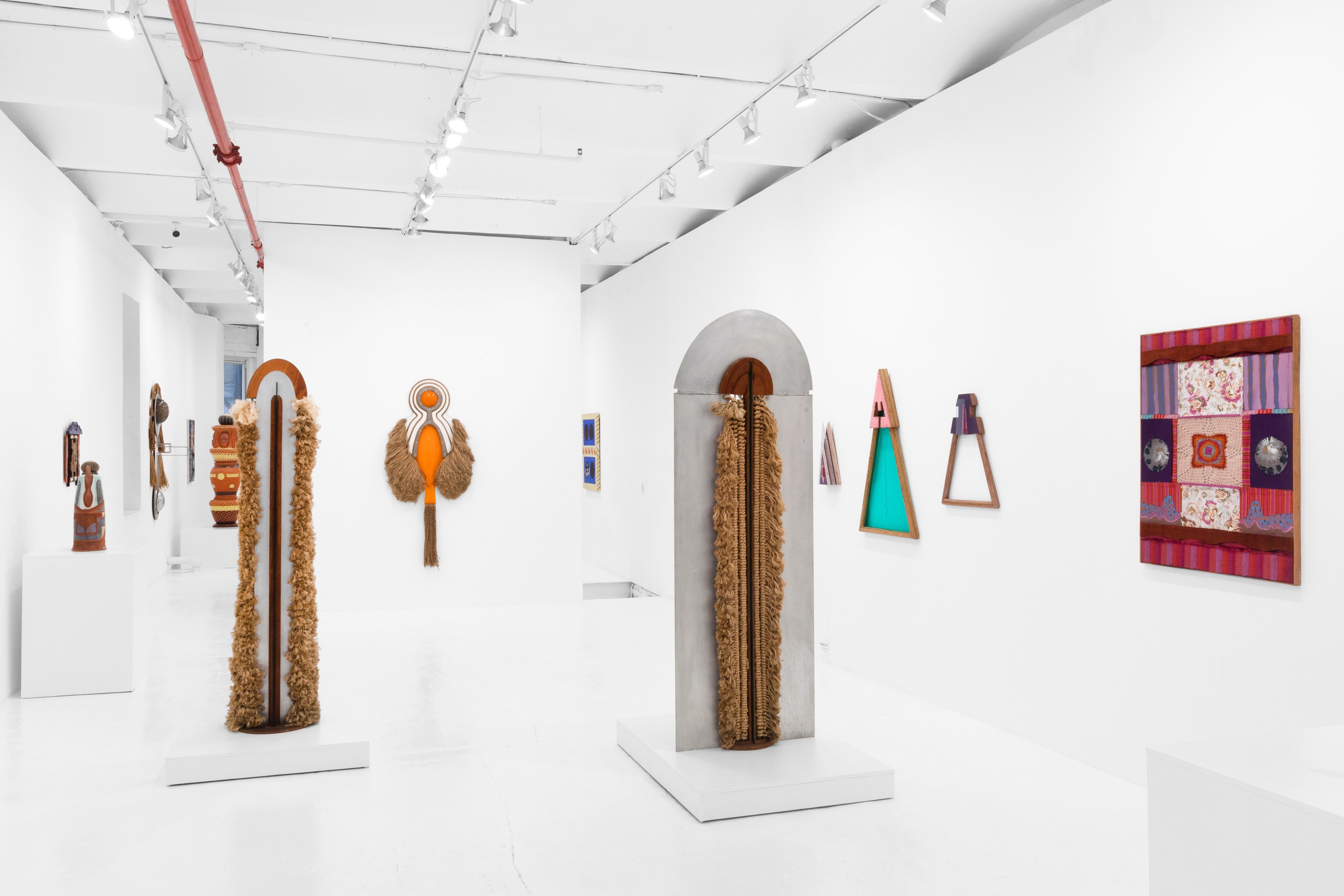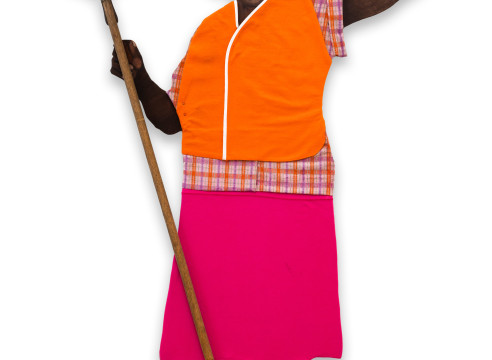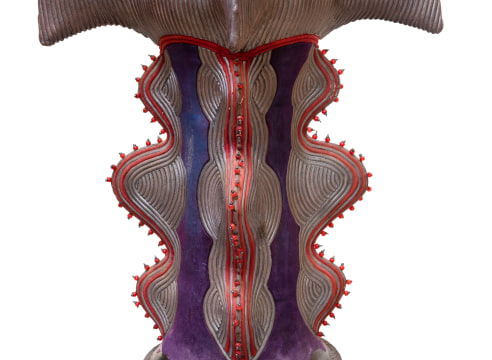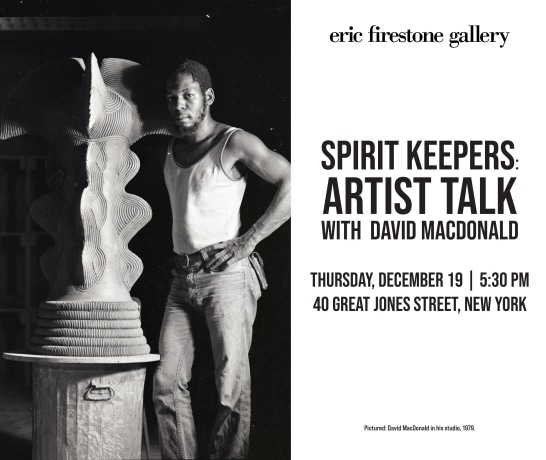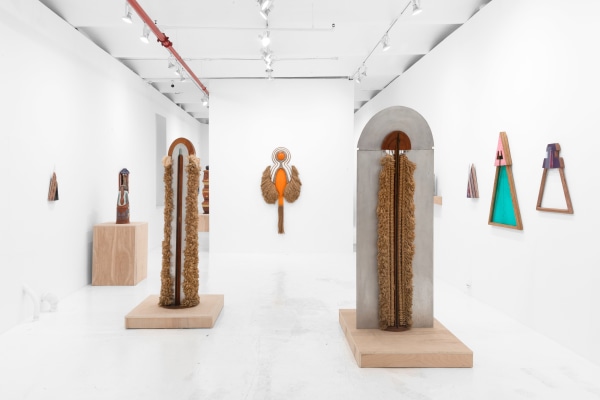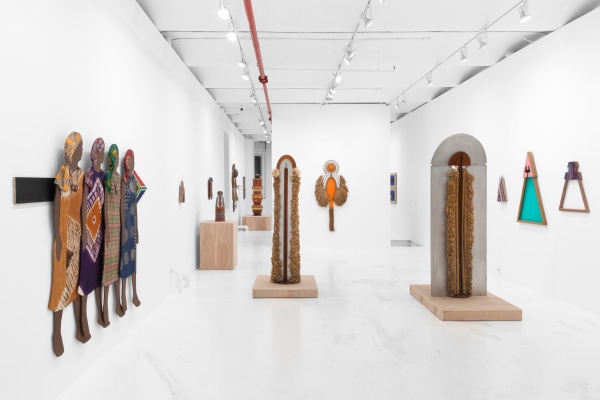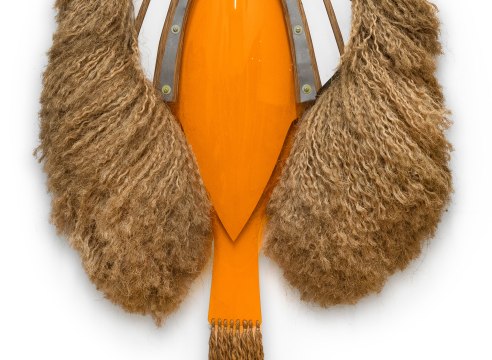
Eric Firestone Gallery is pleased to present Spirit Keepers: Walter C Jackson, Marie Johnson-Calloway, and David MacDonald, an exhibition of three artists working in the Black radical tradition. The exhibition serves as a significant reintroduction in New York City of these artists, showcasing work from the 1970s-90s, a time when each of the artists responded to civil rights activism. They are united in their explorations of family history, African American experience, African heritage, and experimental combinations of materials. Spirit Keeper is the title of two of Jackson’s sculptures, and it becomes an apt descriptor of each of the artists’ goals to preserve legacy and spiritual connections over time.
Marie Johnson-Calloway (1920 – 2018) was a trailblazing artist of the Bay Area who is known for her mixed-media cutouts and assemblage works that honor joy and family life in her community. Walter C Jackson (b. 1940, and based in central New York state), explores portals and a union of opposites in sculptural works that combine organic and industrial materials. David MacDonald (b. 1945) is a Syracuse, NY-based ceramic artist who uses the vessel form and rich patterning to investigate social and spiritual connections.
The textural quality of the works on view is a metaphor for how each of the artists explore personal identity, drawing from African culture and centering Black experience, while also striving for universality, with a focus on beauty and vitality. The exhibition contains a dynamic combination of materials and forms: mixed-media sculptures, assemblage, free-standing totems and wall-works, painting, textile, and ceramic.
The daughter of a Baptist preacher and a teacher, Marie Johnson-Calloway conjured memories of her childhood in segregated Baltimore, showing family members and acquaintances in monumental painted constructions. In 1971, Johnson-Calloway reflected: “I am trying to create images which are intimate reflections of the lives of Black people, images which are deeply rooted in Black dreams, Black suffering, Black pride, Black anger, Black strength and Black love.” Johnson-Calloway began her career in the 1950s, first in Alaska and then in the California Bay Area, where she would establish herself as an essential artist and member of the community for decades.
In the 1960s, her art transcended the dominant cool and mechanical idiom of the day, working with cutouts and the recognizable imagery of daily life. She reintroduced the human figure back into radical art: her collage materials and her figures represented real people in her life. More abstract assemblage sculptures incorporate textile elements and wood into personal shrine-like constructions. The collage materials embed the stories of those who used them. Another series incorporates men’s ties, attached to the canvas, surrounding painted portraits like halos and pyramidal crowns.
David MacDonald is a ceramist whose work over the last four decades has explored African ancestry through its rich patterning and graphic elements. In his early ceramic assemblage work, he responded to pressing civil rights issues by incorporating images from the media using ceramic decals. They reference rhetoric exchanged by then-president Lyndon B. Johnson and Black Panther leaders, depicting images of anger and American hypocrisy. However, beginning in the late 1970s, he became interested in more joyful representations of Black culture and his African ancestry. Drawing upon a variety of design sources in the vast creative tradition of the African continent, MacDonald incorporates elements of the textiles, architecture, and body decoration found in cultures across sub-Saharan Africa. On his vessels and monumentally scaled plates, which hang on the wall like shields, he creates three-dimensional embellishments using a variety of techniques – such as slip trailing or carving – to reference scarification and architecture of the Igbo, Ndebele, and Maasai people. The patterns are additionally also inspired by West African mudcloth and his wife’s quilt pattern books.
MacDonald’s Nyama series references the Swahili word for essential life force. The artist designed these stoneware vessels as containers for the soul and decorated them with beads and jute fibers. MacDonald’s Family Totemic vessel takes the form of a totem, which in West African culture represents royal lineages and symbolizes the passage into the world of the ancestors. MacDonald views works such as this one as memorials to the ancestry of enslaved African people. In response to the 1991 beating of Rodney King by the Los Angeles police, MacDonald began his landmark Middle Passage series, which incorporates imagery related to the Transatlantic slave trade.
Walter C Jackson is a sculptor whose work combines natural materials—such as wood, sisal and jute fibers—alongside industrial plastic and aluminum. Jackson describes his practice as a “unity of opposites,” containing spiritual considerations—with symbolic reference to both African cosmology and Christian iconography influenced by his Methodist upbringing—within the structure of urban geometries. Jackson fuses traditional totemic forms and contemporary aesthetics of light, movement, and refraction. Jackson’s sculptures are often defined by their arched or triangular shape which frames an opening. In the 1970s, Jackson was developing the idea of a passageway, a method of inviting the viewer to enter into the work and of creating a portal between concepts of ritual and technology, past and future. At times, this portal might suggest the Door of No Return and the forced migration of Africans into enslavement.
Jackson’s structural framework draws upon West African Dogon sculpture, Moorish doorways in Spain, pyramidal constructions, and ecclesiastical architecture of the American South. Jackson is particularly interested in the icons of West African spiritual tradition, which he imagines contain an internal energy and give the illusion of being poised for movement. The artist seeks a similar kinetic quality through his use of human scale, electrical illumination, and hair-like filaments within his works. Through these material choices, Jackson channels diverse conceptions of the divine, invoking ancient and ritual traditions as well as contemporary worship via scientific and digital mediums.
Walter C Jackson (b. Holmes County, MS, 1940) grew up in Jackson, Mississippi, completing his MFA from the University of Tennessee, where he studied sculpture, and then joined the faculty, serving as an assistant professor of sculpture until 1980. In the 1980s, having moved to New York City, Jackson exhibited his work at Just Above Midtown and Kenkeleba House. Jackson worked as an adjunct assistant professor at York College of The City University of New York for two years, before joining the Bronx Museum of Arts and eventually becoming executive director at the Bronx River Art Center in 1995. Jackson was selected for an artist-in-residence fellowship at the Studio Museum in Harlem in 1982 alongside Tyrone Mitchell and Janet Henry, and received the artist-in-residence fellowship at the Roswell Museum in 1994. He lives and works in central New York State. His work is held in public collections, including the Tennessee State Museum, Nashville; New York Public Library, The Schomburg Center for Research in Black Culture, New York; The Studio Museum in Harlem, New York; and the Anderson Museum of Contemporary Art, Roswell, NM.
Marie Johnson-Calloway (1920 – 2018), who lived and worked as an artist, activist, and educator in the Bay Area of California for more than 60 years, received her MFA at San Jose State University, California, where she was then hired as the first Black public school teacher in the city. She was active in the Civil Rights Movement of the 1960s, becoming president of the San Jose chapter of the NAACP. In 1965 she participated in the historic march in Selma, Alabama, an experience which changed the direction of her art. She was a member of Art West Associated, which protested the exclusion of Black artists from the Los Angeles County Museum of Art and the Oakland Museum. In 1969, she became an assistant professor at the California College of Arts and Crafts in Oakland. She continued her graduate studies at Stanford University. In the 1970s she was hired as a joint professor of Black studies and art at her alma mater, San Jose State University. There she developed the curriculum on African American Art and began the school’s collection of art by Black artists. She exhibited widely in the 1970s, including a landmark show in conjunction with Betye Saar at the San Francisco Museum of Modern Art in 1977. Saar would become a close friend and the two artists would exhibit together several times over the course of their careers. Johnson-Calloway has been the subject of several institutional exhibitions, including Hope Street, at the Oakland Museum of California, 1987; Homecoming: Marie Johnson Calloway, Past and Present, Morgan State University, Baltimore, MD, 2006; and Marie Johnson Calloway: Legacy of Color, Museum of African Diaspora, San Francisco, CA, 2015. Her work was included in Now Dig This! Art and Black Los Angeles 1960–1980, at the Hammer Museum, Los Angeles, CA, 2011. Her work is represented in the collections of the San Jose State University, the California Museum of African American Art, and the Brooklyn Museum, NY, among others.
David MacDonald (b. Hackensack, NJ, 1945) studied at Hampton University in Virginia, where he majored in art education, and encountered his mentor: ceramic artist Joseph W. Gilliard. MacDonald was awarded a graduate fellowship at the University of Michigan, where he studied with John Stephenson and ceramist Robert Stull. Encouraged by his teachers, Macdonald focused on social and political commentary within his work. After completing his MFA, he joined the faculty of the School of Art and Design at Syracuse University, where he would teach for forty years. MacDonald received the Excellence in Teaching Award from the National Council on Education for the Ceramic Arts (NCECA) in 2011. In 1979, he was the subject of an exhibition at the Studio Museum in Harlem, NY, Vessels for the Human Spirit. Work from this historic show will be on view at Eric Firestone Gallery. He has been the subject of numerous solo university museum exhibitions, including Queens College, Charlotte, NC; North Carolina Wesleyan College, Rocky Mount, NC; Daura Gallery, Lynchburg College, Lynchburg, VA; List Gallery, Swarthmore College, Swarthmore, PA; Hampton University, Hampton, VA; Fosdick-Nelson Gallery, New York College of Ceramics at Alfred University, Alfred, NY; and Tyler Art Gallery, State University of New York at Oswego, Oswego, NY. In 2011, he was the subject of The Power of Pattern, an exhibition at the Everson Museum of Art, Syracuse, NY. His work is in the permanent collections of the Studio Museum in Harlem, New York; Montclair Art Museum, New Jersey; and the Everson Museum of Art, Syracuse.
The three artists embody the role of “Spirit Keepers” through their work. Jackson’s work is embedded with and influenced by the folktales and blues from his childhood in Mississippi. Johnson-Calloway’s work preserves everyday life, family history, and the work of civil rights activists in her multi-media constructions. MacDonald uses the vessel form to contain, in his words, “the essence of humanity.”

